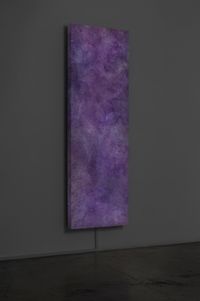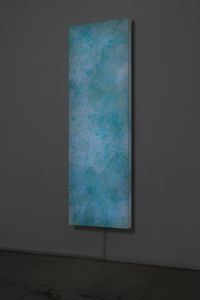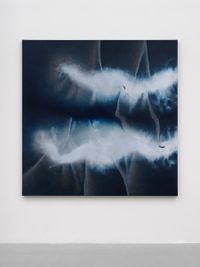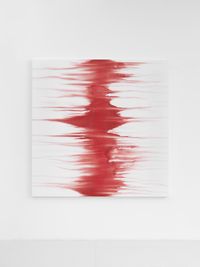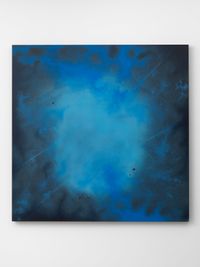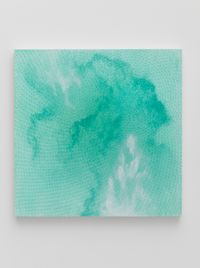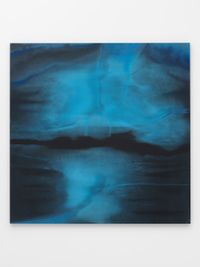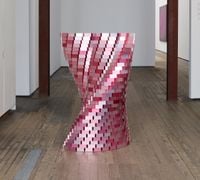Since the 1980s, London-based Iranian artist Shirazeh Houshiary has expanded her practice from sculpture to include painting, video installation, animation and virtual reality. Recognised for her monochromatic paintings that explore the opposing ideas of transparency, instability, the cosmos and the individual, Houshiary considers the constantly shifting nature of identity and the universe.
Read MoreUpon graduating from Chelsea College of Arts, London, in 1979, Houshiary became a leading member of the New British Sculpture movement in the 1980s alongside her contemporaries Tony Cragg, Richard Deacon and Anish Kapoor. Her early sculptures—mainly made of copper—feature abstracted, curvilinear shapes that are suggestive of calligraphic lines. In 1994 she was nominated for the Turner Prize for her The Enclosure of Sanctity (1992–3)—a set of five metal cubes that capture and reflect light—and Licit Shadow (1993)—a group of six metals boxes in which she juxtaposed the cold impression of the lead with accents of copper and gold.
Houshiary's labourious paintings—created by pouring washes of pigment on the canvas and inscribing its surface with details in pencil or paint—are occupied by binary forces. In Soar (2015)—a square painting of hazy blue—clouds of violet and darker blue streaks are composed of the words 'I am' and 'I am not' in Arabic. Repeating the words until they became illegible, Houshiary visualises the opposing forces of self-affirmation and denial. Veil (1999)—another square painting—is a work that conceals as well as reveals. After painting the canvas in black acrylic, the artist used graphite to write Sufi thoughts in Arabic. As a result of the combination of graphite on acrylic, the painting appears unequivocally black from a distance, but shifts upon closer inspection to disclose a square form reminiscent of Malevich's Black Square (1915).
Indeed, many of Houshiary's monochromatic paintings are meant to be encountered both from a distance, where they seem to resemble the cosmos, and in proximity, where detailed patterns begin to emerge. In other words, the experience of her artworks is unfixed. According to Houshiary, everything—from our physical bodies to nature and the universe—is subject to change, yet we as humans persistently search for stability. Through her frequent use of capricious techniques, such as pouring water over the canvas and allowing it to influence her markings (as seen in the triptych Flit [2017]), the artist reminds us that notions of constancy are, in fact, artificial.
Fascinated by Stephen Hawking's analogy of a goldfish in a glass bowl, in which the fish's vision of the outside world is affected by the glass, Houshiary suggests that our understanding of the world is similarly restricted by our conditions, saying her works are a way of '[glimpsing] at something that is in between all these stages.' In Breath (2003)—a video installation included in the Collateral Event of the 55th Venice Biennale (2013)—prayers from four different religions are represented as the mist of four vocalists' breath. Such preoccupation with the embodiment of breath and spirituality recur throughout her works such as in Presence (2006–7), a square painting on black acrylic ground that encases a smaller, blue square form composed of Arabic words in colour pencil.
In addition to borrowing from Sufi doctrine, Houshiary also draws inspiration from the work of Rumi, the 13th-century Persian mystic poet. The sculpture Exuviae (2017) poses the inevitability of change against fixity. Titled after the word for the skin left by animals after metamorphosis—especially by insect larva or snakes—the helical column is composed of Italian glass blocks that reference the way we discard old ideas for the new. The transparent quality of glass recalls liquid or water, elements commonly used in Houshiary's paintings.
In addition to holding multiple solo and group exhibitions at Lisson Gallery, New York, and Lehmann Maupin, Hong Kong and New York, Houshiary has also exhibited at STPI, Singapore (2015); The Museum of Modern Art, New York (2007, 2006); Tate Liverpool (2003); Mori Art Museum, Tokyo (2003); Museum of Contemporary Art Chicago (1996); Tate Gallery, London (1994, 1983); and Camden Arts Centre, London (1993) among others. In 1989 her work was included in the historical exhibition Les Magiciens de la Terre at Centre Pompidou, Paris. The Turner Prize nominee has also participated in numerous biennials including the Venice Biennale (2017, 1993, 1982); Kyiv Biennale (2012); Biennale of Sydney (2010) and Bienal de São Paulo (1996). Houshiary lives and works in London.
Sherry Paik | Ocula | 2018
